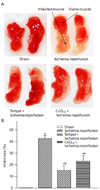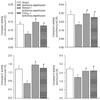Tourniquet-induced acute ischemia-reperfusion injury in mouse skeletal muscles: Involvement of superoxide
- PMID: 21036124
- PMCID: PMC3008320
- DOI: 10.1016/j.ejphar.2010.10.037
Tourniquet-induced acute ischemia-reperfusion injury in mouse skeletal muscles: Involvement of superoxide
Abstract
Although arterial limb tourniquet is one of the first-line treatments to prevent exsanguinating hemorrhage in both civilian pre-hospital and battlefield casualty care, prolonged application of a limb tourniquet can lead to serious ischemia-reperfusion injury. However, the underlying pathomechanisms of tourniquet-induced ischemia-reperfusion injury are still poorly understood. Using a murine model of acute limb ischemia-reperfusion, we investigated if acute limb ischemia-reperfusion injury is mediated by superoxide overproduction and mitochondrial dysfunction. Hind limbs of C57/BL6 mice were subjected to 3h ischemia and 4h reperfusion via placement and release of a rubber tourniquet at the greater trochanter. Approximately 40% of the gastrocnemius muscle suffered infarction in this model. Activities of mitochondrial electron transport chain complexes including complex I, II, III, and IV in the gastrocnemius muscle were decreased in the ischemia-reperfusion group compared to sham. Superoxide production was increased while activity of manganese superoxide dismutase (MnSOD, the mitochondria-targeted SOD isoform) was decreased in the ischemia-reperfusion group compared to the sham group. Pretreatment with tempol (a SOD mimetic, 50mg/kg) or co-enzyme Q(10) (50mg/kg) not only decreased the superoxide production, but also reduced the infarct size and normalized mitochondrial dysfunction in the gastrocnemius muscle. Our results suggest that tourniquet-induced skeletal muscle ischemia-reperfusion injuries including infarct size and mitochondrial dysfunction may be mediated via superoxide overproduction and reduced antioxidant activity. In the future, this murine ischemia-reperfusion model can be adapted to mechanistically evaluate anti-ischemic molecules in tourniquet-induced skeletal muscle injury.
Copyright © 2010 Elsevier B.V. All rights reserved.
Conflict of interest statement
No conflicts of interest are declared by the authors.
Figures






Similar articles
-
Mitochondria-derived superoxide links to tourniquet-induced apoptosis in mouse skeletal muscle.PLoS One. 2012;7(8):e43410. doi: 10.1371/journal.pone.0043410. Epub 2012 Aug 17. PLoS One. 2012. PMID: 22912870 Free PMC article.
-
Remote and local ischemic postconditioning further impaired skeletal muscle mitochondrial function after ischemia-reperfusion.J Vasc Surg. 2012 Sep;56(3):774-82.e1. doi: 10.1016/j.jvs.2012.01.079. Epub 2012 Jul 15. J Vasc Surg. 2012. PMID: 22796117
-
Remote and local ischemic preconditioning equivalently protects rat skeletal muscle mitochondrial function during experimental aortic cross-clamping.J Vasc Surg. 2012 Feb;55(2):497-505.e1. doi: 10.1016/j.jvs.2011.07.084. Epub 2011 Nov 4. J Vasc Surg. 2012. PMID: 22056287
-
[Novel findings from an animal tourniquet shock model].Nihon Hoigaku Zasshi. 2003 Sep;57(2):125-34. Nihon Hoigaku Zasshi. 2003. PMID: 14574964 Review. Japanese.
-
A Unifying Mechanism for Mitochondrial Superoxide Production during Ischemia-Reperfusion Injury.Cell Metab. 2016 Feb 9;23(2):254-63. doi: 10.1016/j.cmet.2015.12.009. Epub 2016 Jan 14. Cell Metab. 2016. PMID: 26777689 Review.
Cited by
-
Enhanced autophagy alleviates injury during hindlimb ischemia/reperfusion in mice.Exp Ther Med. 2019 Sep;18(3):1669-1676. doi: 10.3892/etm.2019.7743. Epub 2019 Jul 8. Exp Ther Med. 2019. PMID: 31410124 Free PMC article.
-
CoenzymeQ10 and Ischemic Preconditioning Potentially Prevent Tourniquet-Induced Ischemia/Reperfusion in Knee Arthroplasty, but Combined Pretreatment Possibly Neutralizes Their Beneficial Effects.Antioxidants (Basel). 2022 Feb 18;11(2):419. doi: 10.3390/antiox11020419. Antioxidants (Basel). 2022. PMID: 35204301 Free PMC article.
-
Muscles Susceptibility to Ischemia-Reperfusion Injuries Depends on Fiber Type Specific Antioxidant Level.Front Physiol. 2017 Feb 6;8:52. doi: 10.3389/fphys.2017.00052. eCollection 2017. Front Physiol. 2017. PMID: 28220081 Free PMC article.
-
Mitochondrial protein S-nitrosation protects against ischemia reperfusion-induced denervation at neuromuscular junction in skeletal muscle.Free Radic Biol Med. 2018 Mar;117:180-190. doi: 10.1016/j.freeradbiomed.2018.02.006. Epub 2018 Feb 9. Free Radic Biol Med. 2018. PMID: 29432799 Free PMC article.
-
Effect of epigallocatechin gallate on ischemia-reperfusion injury: an experimental study in a rat epigastric island flap.Int J Clin Exp Med. 2014 Jan 15;7(1):57-66. eCollection 2014. Int J Clin Exp Med. 2014. PMID: 24482689 Free PMC article.
References
-
- Beauchamp C, Fridovich I. Superoxide dismutase: improved assays and an assay applicable to acrylamide gels. Anal. Biochem. 1971;44:276–287. - PubMed
-
- Becker LB, vanden Hoek TL, Shao ZH, Li CQ, Schumacker PT. Generation of superoxide in cardiomyocytes during ischemia before reperfusion. Am. J. Physiol. 1999;277:H2240–H2246. - PubMed
-
- Beekley AC, Sebesta JA, Blackbourne LH, Herbert GS, Kauvar DS, Baer DG, Walters TJ, Mullenix PS, Holcomb JB. Prehospital tourniquet use in Operation Iraqi Freedom: effect on hemorrhage control and outcomes. J. Trauma. 2008;64:S28–S37. - PubMed
-
- Bellamy RF. The causes of death in conventional land warfare: implications for combat casualty care research. Mil. Med. 1984;149:55–62. - PubMed
-
- Bickell WH, Wall MJ, Jr, Pepe PE, Martin RR, Ginger VF, Allen MK, Mattox KL. Immediate versus delayed fluid resuscitation for hypotensive patients with penetrating torso injuries. N. Engl. J. Med. 1994;331:1105–1109. - PubMed
Publication types
MeSH terms
Substances
Grants and funding
LinkOut - more resources
Full Text Sources

